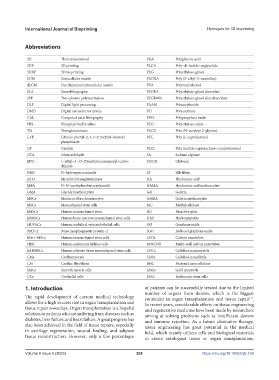Page 216 - IJB-9-5
P. 216
International Journal of Bioprinting Hydrogels for 3D bioprinting
Abbreviations
3D Three dimensional PGA Polyglycolic acid
3DP 3D printing PLGA Poly–dl–lactide–coglycolide
3DBP 3D bioprinting PEG Polyethylene glycol
ECM Extracellular matrix PAOXA Poly (2–alkyl–2–oxazoline)
dECM Decellularized extracellular matrix PVA Polyvinyl alcohol
SLA Stereolithography PEGDA Polyethylene glycol diacrylate
2PP Two–photon polymerization PEGDMA Polyethylene glycol dimethacrylate
DLP Digital light processing PAAM Polyacrylamide
DMD Digital micromirror device PU Polyurethane
CAL Computed axial lithography PPO Polypropylene oxide
PBS Phosphate buffer saline PEO Polyethylene oxide
TG Transglutaminase PACG Poly (N–acryloyl 2–glycine)
LAP Lithium phenyl–2, 4, 6–trimethyl–benzoyl PCL Poly (ε–caprolactone)
phosphinate
GP Genipin PLCL Poly (lactide–caprolactone–cocaprolactone)
GTA Glutaraldehyde SA Sodium alginate
EDC 1–ethyl–3 –(3–Dimethylaminopropyl) carbo- CS/CH Chitosan
diimide
NHS N–hydroxysuccinimide SF Silk fibrin
mTG Microbial transglutaminase HA Hyaluronic acid
MBA N–N’–methylenebis(acrylamide) HAMA Hyaluronic acid methacrylate
GMA Glycidyl methacrylate Gel Gelatin
MFCs Meniscus fibrochondrocytes GelMA Gelatin methacrylate
MSCs Mesenchymal stem cells MC Methylcellulose
hMSCs Human mesenchymal stem BG Bioactive glass
hBMSCs Human bone marrow mesenchymal stem cells HAP Hydroxyapatite
HUVECs Human umbilical vein endothelial cells GO Graphene oxide
BMP–2 Bone morphogenetic protein–2 rGO Reduced graphene oxide
hTert–MSCs Human mesenchymal stem cells CNTs Carbon nanotubes
HEK Human embryonic kidney cells MWCNT Multi–wall carbon nanotubes
hADMSCs Human adipose tissue mesenchymal stem cells CNCs Cellulose nanocrystals
CMs Cardiomyocyte CNFs Cellulose nanofibrils
CFs Cardiac fibroblasts BNC Bacterial nanocellulose
SMCs Smooth muscle cells GNRs Gold nanorods
UCs Urothelial cells ESCs Embryonic stem cells
1. Introduction of patients can be successfully treated due to the limited
number of organs from donors, which is the biggest
The rapid development of current medical technology constraint in organ transplantation and tissue repair .
[1]
allows for a high success rate in organ transplantation and In recent years, considerable efforts on tissue engineering
tissue repair nowadays. Organ transplantation is a hopeful and regenerative medicine have been made by researchers
solution to patients who are suffering from diseases such as aiming at solving problems such as insufficient donors
diabetes, liver failure, and heart failure. A great progress has and immune rejection. As a future alternative therapy,
also been achieved in the field of tissue repairs, especially tissue engineering has great potential in the medical
in cartilage regeneration, wound healing, and adipose field, which mainly utilizes cells and biological materials
tissue reconstruction. However, only a few percentages to create autologous tissue or organ transplantation.
Volume 9 Issue 5 (2023) 208 https://doi.org/10.18063/ijb.759

